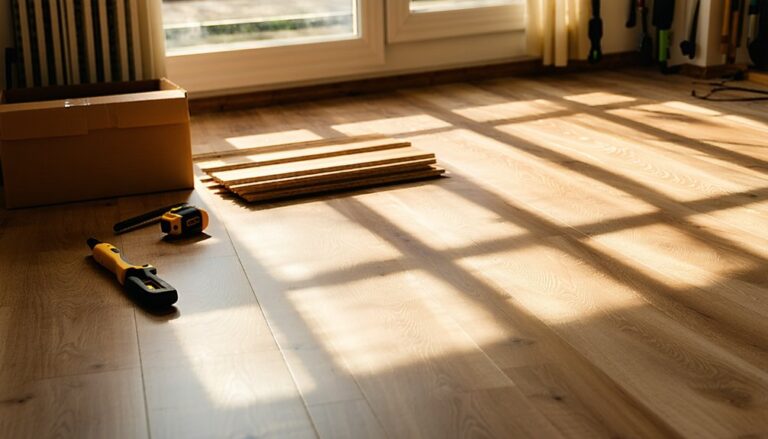To clean paint off wood floors, first identify if the paint is water- or oil-based by checking the label or testing with rubbing alcohol. For wet paint, blot gently and scrape with a plastic tool, then wipe with soapy water. Dried paint may need softening with soap or gentle sanding along the grain. Always test solvents on a hidden spot and protect the floor with coverings. After removal, restore the finish carefully for a seamless look. Keep following for detailed, step-by-step guidance.
Identifying the Type of Paint on Your Wood Floor

Before you begin cleaning paint off your wood floor, it’s essential to identify the type of paint you’re dealing with. This knowledge lets you choose the right removal method without damaging your floor. Oil based paints are thicker, have a glossy finish, and tend to dry harder. They’re harder to remove and often require solvents like mineral spirits. Water based paints, including latex, dry faster and feel more flexible when dry. They’re easier to clean with soap and water or mild detergents when still fresh. To identify, check the paint can label if available or test a small hidden spot using rubbing alcohol—water based paints will soften, oil based won’t. Correct identification empowers you to act confidently and preserve your wood floor’s beauty.
Removing Wet Paint From Wood Floors
If you catch paint on your wood floor while it’s still wet, act quickly to prevent it from spreading or soaking in. Use a gentle cleaning solution, like a mixture of warm water and mild soap, applied with a soft cloth to carefully lift the paint. Make sure to contain the area to avoid smearing the paint onto clean sections of the floor.
Immediate Action Steps
When you notice wet paint on your wood floor, act quickly to prevent it from setting and causing permanent damage. Immediate cleaning is essential. First, gently blot the area with a clean, dry cloth to absorb excess paint—avoid rubbing, which can spread it. Next, use a plastic scraper or an old credit card to carefully lift off as much paint as possible without scratching the wood. For quick solutions, dampen a cloth with warm soapy water and gently wipe the spot, ensuring you don’t saturate the wood. Always test any method on a small, hidden area first. The faster you respond with these immediate actions, the better your chances of removing the paint without damaging your wood floor’s finish or texture.
Safe Cleaning Solutions
Although acting quickly is essential, choosing the right cleaning solution guarantees you won’t damage your wood floor while removing wet paint. Opting for natural cleaners or eco friendly options helps protect both your pavimentazione and the environment. When tackling wet paint, follow these steps:
- Test your chosen cleaner on a small, hidden area to verify it won’t discolor or damage the wood finish.
- Use gentle, biodegradable solutions like diluted vinegar, mild dish soap, or a citrus-based cleaner to soften the paint without harsh chemicals.
- Apply with a soft cloth or sponge, gently rubbing to lift paint without scratching.
Avoid abrasive tools or harsh solvents that could strip varnish or stain. By selecting safe, eco friendly cleaning agents, you maintain your floor’s beauty and your freedom to enjoy a healthy home.
Preventing Paint Spread
Since wet paint can quickly spread and worsen the mess, it’s essential to act immediately to contain it. Start by setting up clear barriers around your painting area to prevent accidental tracking. Use drop cloths or plastic sheeting securely taped down to catch any drips. Practice paint drip prevention by regularly wiping your brushes and rollers on the tray edge before moving them. Keep your workspace organized—store paint cans tightly closed and place tools on a designated surface to avoid spills. If you spot a paint drip, gently blot it with a damp cloth rather than wiping, which can spread the paint. Taking these steps keeps your floors protected and grants you the freedom to work without fearing a bigger cleanup later.
Techniques for Cleaning Dried Paint Stains
Tackling dried paint stains on wood floors requires patience and the right approach to avoid damaging the surface. For effective cleaning techniques and paint removal, start by gently scraping off the bulk of the dried paint with a plastic scraper to prevent scratches. Then, soften remaining paint using warm, soapy water applied with a cloth. If the stain persists, carefully use fine steel wool or a sanding block, but only along the wood grain to avoid surface damage. Follow these steps:
- Scrape gently with a plastic tool to remove loose paint.
- Apply warm, soapy water to soften and wipe away residue.
- Lightly sand stubborn spots, always with the grain.
Safe Solvents and Tools for Paint Removal

When removing paint from wood floors, you’ll want to choose non-toxic solvents to protect both your health and the finish. Use soft tools like plastic scrapers or brushes to avoid scratching the surface. Always test your chosen solvent and tool on a hidden spot first to guarantee it won’t damage the wood.
Choosing Non-Toxic Solvents
Although removing paint from wood floors can be challenging, choosing non-toxic solvents guarantees you protect both your health and the finish of your flooring. Opting for eco friendly options with natural ingredients minimizes harsh chemical exposure while effectively loosening paint.
Here’s how to select the right solvent:
- Prioritize products labeled as biodegradable or plant-based—they’re safer for your lungs and pets.
- Test the solvent on a hidden area to verify it doesn’t dull or damage the wood’s finish.
- Use minimal amounts to avoid oversaturating the floor, which can cause warping or staining.
Soft Tools for Scraping
After selecting a non-toxic solvent that won’t harm your wood floor, you’ll need the right tools to safely remove softened paint without scratching or gouging the surface. Choose plastic scrapers and rubber spatulas—they provide firm yet gentle edges to lift paint without damaging the wood. Avoid metal tools which can leave permanent marks. Hold your scraper at a low angle and apply steady, controlled pressure to gently peel away loosened paint. Use rubber spatulas for delicate spots or grooves where plastic scrapers can’t reach. Keep wiping the area with a clean cloth to monitor progress and prevent residue buildup. By combining safe solvents with these soft tools, you maintain the integrity of your wood floor while effectively removing paint, giving you freedom to restore your space without worry.
Testing on Hidden Areas
How can you guarantee that the solvent and tools you choose won’t damage your wood floor? Start by always testing on a hidden spot before applying anything more broadly. This test area lets you observe any adverse reactions without risking visible damage. Follow these steps:
- Select a hidden spot, such as under a piece of furniture or inside a closet.
- Apply a small amount of the solvent or test the tool gently.
- Wait several minutes to check for discoloration, warping, or finish removal.
Protecting Wood Floors During Paint Cleanup

Before you begin cleaning paint off your wood floors, it’s crucial to take steps that prevent further damage or staining. Start by placing protective coverings or floor mats around the work area to catch any drips or splatters. These barriers not only shield your floors but also give you the freedom to work confidently without worry. Use soft, non-abrasive materials for coverings to avoid scratching the wood. If you’re using liquid cleaners, make certain that the protective coverings can absorb spills or prevent liquids from seeping through. Additionally, keep your cleaning tools and solvents contained within the protected area to minimize accidental contact with exposed floor surfaces. By preparing your workspace carefully, you’ll protect your wood floors effectively during paint cleanup and maintain their natural beauty.
Tips for Preventing Paint Spills on Wood Floors
One effective way to prevent paint spills on wood floors is to establish a controlled workspace that limits accidental drips. To maximize paint prevention and floor protection, follow these three essential steps:
Create a controlled workspace to limit drips and protect your wood floors during painting projects.
- Lay down high-quality drop cloths or plastic sheeting, securing edges with painter’s tape to prevent shifting.
- Use a paint tray with a guard to minimize splatter and avoid overloading your brush or roller.
- Keep a damp cloth or paper towels handy for immediate cleanup of small drips before they dry.
Restoring the Finish After Paint Removal
Once you’ve successfully removed paint from your wood floors, restoring the finish is essential to protect the surface and maintain its appearance. Start by gently sanding the area with fine-grit sandpaper to smooth any roughness left from paint removal. Clean the dust thoroughly using a vacuum and a damp cloth. Next, apply a wood conditioner if the floor is unfinished or damaged, allowing it to absorb evenly. Choose a finish that matches the existing one—polyurethane, varnish, or wax—and apply it evenly with a brush or cloth. Allow each coat to dry completely before adding another. These finishing touches complete the wood restoration process, ensuring your floor looks natural and well-protected. Taking these steps will help your floors stay beautiful and durable for years to come.




